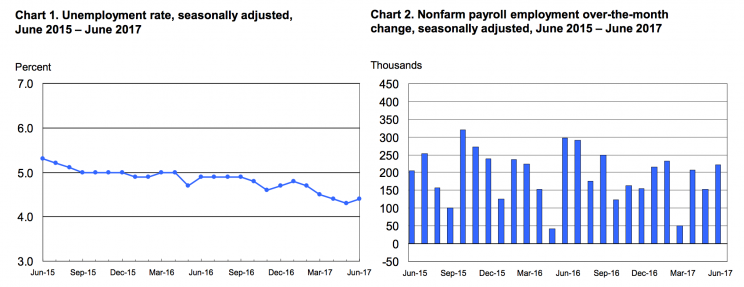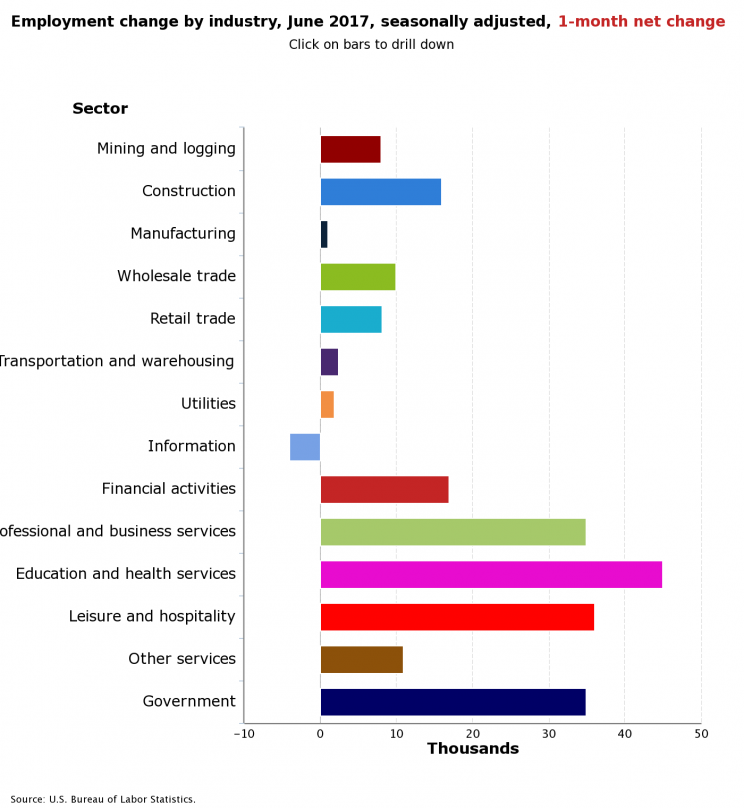June U.S. jobs report beats expectations
The June jobs report is out and it’s a beat.
The economy added 222,000 jobs in June, more than expected, while the unemployment rate rose slightly to 4.4%. Over the last three months jobs gains have now averaged 194,000 per month.
The uptick in the unemployment rate comes as the labor force participation rate also rose slightly, to 62.8% from 62.7% in May. Average weekly hours worked also rose to 34.5 from 34.4.
Economists were expecting there to be 178,000 jobs added to the economy in June while the unemployment rate was set to remain at 4.3%, a post-financial crisis low.

Wage gains in June, however, were disappointing with average hourly earnings rising 0.2% over the prior month and 2.5% over the prior year.
Average hourly earnings are a key measure of potential inflation pressures and are closely watched by economists; wages were expected to rise 0.3% over the prior month and 2.6% over the prior year in June.
In May, wage gains were disappointing, rising 0.2% over the prior month and just 2.5% over the prior year. These figures were also revised down in Friday’s report to show gains were just 0.1% over last month and 2.4% over last year in May.

Following this report, stocks were higher with the Dow up 40 points, the S&P 500 up about 6, and the Nasdaq up 27. This comes after a broad sell-off on Thursday saw the tech-heavy Nasdaq lose 1% and the Dow fall more than 150 points. Bond yields were mixed after the report with the 10-year yield slightly higher to 2.38% and the 2-year lower to trade near 1.39%.
By sector, the bulk of job gains were seen in the services space, led by by health care and social assistance jobs which were up by 59,000 in June. Education and health services employment grew by 45,000 in June while leisure and hospitality jobs grew by 36,000.
Government employment was also a boost for overall job gains, rising by 35,000 in June after a net gain of just 6,000 jobs for the sector in the prior two months.
The goods-producing sector, which includes the coal and manufacturing jobs so often discussed by President Donald Trump, added 25,000 jobs in June. One thousand jobs were added in the manufacturing sector, 16,000 jobs were added in construction, while eight thousand were added in mining and logging.

Markets and economists were also keeping an eye on the underemployment rate, which includes not only those unemployed but workers who are employed part-time but would like full-time work. In June, the underemployment rate rose to 8.6%; in May, the underemployment rate fell to 8.4%, the lowest reading since June 2007.
President Donald Trump’s chief economist advisor Gary Cohn has said in recent months that the administration is focused on bringing this rate down.
May’s headline job gains were also revised up slightly on Friday, with the BLS now saying that 152,000 jobs were added in May, more than the 138,000 initially reported. April’s job gains were also positively revised, with the economy adding an estimated 207,000 jobs during the month, up from 174,000.
Ahead of the report, some Wall Street economists said they expected a bounce-back in Friday’s report due to a seasonal-adjustment quirk from the BLS that could have negatively impacted the May data.
“Historically, May employment is stronger when the survey week falls in the third week of the month as opposed to the second week,” writes Michael Gapen, an economist at Barclays. “History suggests that any shortfall in May employment growth due to calendar day effects will be largely reversed in June.”
Gapen is forecasting payrolls grew by 185,000 in June, just above the consensus estimate, and sees the unemployment rate declining to 4.2%.
Yahoo Finance’s Nicole Sinclair also noted Thursday that the retail sector is a space to watch in Friday’s report, as the sector has already seen about 60,000 job losses in the first half of this year. In June, retail jobs grew by 8,100, bouncing back after declines in the prior two months.
—
Myles Udland is a writer at Yahoo Finance. Follow him on Twitter @MylesUdland
